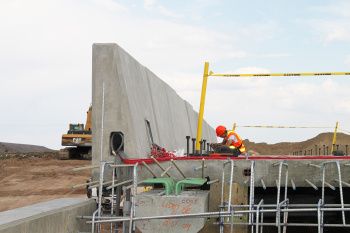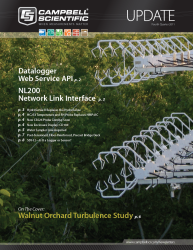 The Utah Department of Transportation is investigating the benefits of using rods made of glass-fiber-reinforced polymer (GFRP) in bridge decks. The GFRP rods resist corrosion caused by deicing salts, and as a result may extend the lifespan of the deck from 45 to 100 years. Corrosion resistance is the biggest factor in reducing the long-term cost of bridge decks.
The Utah Department of Transportation is investigating the benefits of using rods made of glass-fiber-reinforced polymer (GFRP) in bridge decks. The GFRP rods resist corrosion caused by deicing salts, and as a result may extend the lifespan of the deck from 45 to 100 years. Corrosion resistance is the biggest factor in reducing the long-term cost of bridge decks.
UDOT chose the Beaver Creek Bridge as a subject of this investigation for two reasons: (1) it was constructed using precast concrete deck panels reinforced with GFRP rods, and (2) accelerated bridge construction techniques with prestressed concrete girders were used, and the DOT also wanted to test that method. The University of Utah (U of U) instrumented the bridge during construction and performed tests to determine if the new methods and GFRP construction materials provided the required performance.
Testing began in the construction phase and continued after construction was complete. Foil strain gages were installed on the GFRP rods of two of the deck panels before they were cast, and dataloggers recorded strain data each time the panels were lifted. When the panels were in place on the bridge, vibrating wire strain gages (VWSGs) were installed to record:
- Strains induced by post-tensioning
- Strains during the truck-load test
- Change in strain caused by creep and other long-term factors
 U of U researchers used accelerometers attached to the bottoms of some of the girders to:
U of U researchers used accelerometers attached to the bottoms of some of the girders to:
- Record peak accelerations during truck load tests
- Record acceleration signatures during long-term monitoring
- Trigger a camera
The camera recorded images of the vehicles that caused the greatest acceleration measurements.
The researchers installed linear-variable-differential transducers (LVDTs) above the diaphragms between the girders to measure deflection of the deck. During the load tests, they also used surveying equipment to measure deflection of the girders.
The project used two CR3000 Microloggers®, one CR1000 datalogger, one AVW200 vibrating wire interface (to manage signals from the VWSGs), three AM16/32A multiplexers, and one CC640 digital camera. During lifting and transportation of the deck panels, the dataloggers transmitted the recorded data to a laptop using RF401 radios. For the truck load tests, the dataloggers were connected directly to the laptop. For the long-term monitoring portion of the project, a cell modem connected the dataloggers to the Internet, allowing data to be retrieved from anyplace with Internet access.
Collected data includes concrete strains in the deck panels, relative displacements of the panels with respect to the girders, and vertical accelerations. Using the curvature, displacement, and acceleration parameters, conclusions were made regarding the response of the deck and the girders by comparing test results to design requirements, as well as to finite element analyses from computer-generated models.
Computer-generated models of the bridge showed the flexural response of the deck panels, the dynamic response relative to the location of vehicles, and the static relative displacements at mid span. The research showed that, after two years in service, the performance of the bridge, including the precast deck, is well within the design requirements, validating GFRP rods as a viable choice for bridge construction.
Photos courtesy of Dr. Chris P. Pantelides, Civil And Environmental Engineering, University of Utah

